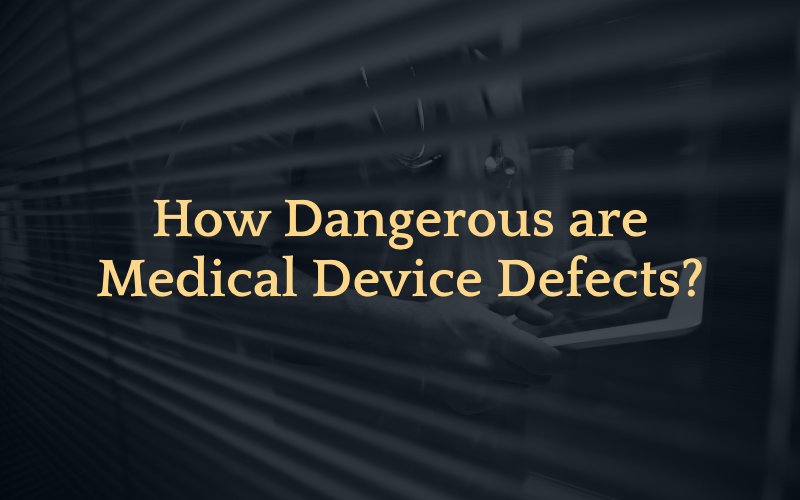No recovery • no fee
480.991.7677
scottsdale • phoenix
How Dangerous Are Medical Device Defects?
Published on January 9, 2024
Medical devices are life-saving for many individuals, and many greatly improve a patient’s quality of life. But when these critical devices are defective, it places medically vulnerable patients at tremendous risk. Injuries, negative health impacts, and sometimes death result from defective medical devices. So, how common are medical device defects? According to data from The U.S. Product Safety and Recall Index, defective medical devices are the cause of an unprecedented rise in product recalls. Medical device recalls increased by five percent during the first quarter of 2023 alone. Recalls were issued for an astonishing 83.3 million medical devices due to faulty manufacturing. But just how dangerous are defective medical devices to patients who depend on them?

What Are Medical Devices?
The World Health Organization (WHO) describes medical devices as non-drug objects used in patient care, including implements, instruments, equipment, implants, and apparatuses used alone or in combination with others for medical treatment. There are around two million kinds of medical devices in common use today. Medical devices are used in diverse settings, including at the patient’s home as well as in hospitals, clinics, and other medical facilities. Many forms of medical devices are implanted directly into the patient’s body. They are used to support mobility as well as for the treatment of chronic conditions, screenings, and palliative care. According to WHO, most of today’s common medical procedures wouldn’t be available without medical devices.
Because the range of medical devices is so varied, there are many ways that these devices can become defective. The development of monitoring software for medical devices is a hopeful tool for the future to quickly identify defects and malfunctions before they can cause injuries, but for now, patients must remain alert to signs and symptoms of potential problems with their medical devices.
Serious Dangers From Malfunctioning Medical Devices
Because medical devices come in such a great variety of forms and functions, so do the dangers of defects. Problems with medical devices can cause incidents ranging from mild inconvenience to fatal injuries. Defective medical devices have caused many medical problems but some of the most commonly known problems from defective medical devices include the following:
- Complications from degrading or migrating surgical mesh
- Loosened or corroded hip or knee implants
- Faulty CPAP machines
- Defective prosthetics
- Defective insulin pumps
- Defective cochlear implants
- Defective stents
- Faulty IUDs
- Defective pain pumps
- Pacemaker defects or malfunctions
- Defective defibrillators
- DaVinci Robot malfunctions
- Defective Inferior Vena Cava Filter (for blood clots)
The Food and Drug Administration (FDA) is responsible for closely regulating medical devices and monitoring their safety and effectiveness once they are on the market. Despite the FDA’s efforts, defective medical devices continue to make it to market. Defective products—including medical devices—become faulty in one of five ways:
- A defective design leaves the product faulty from the start
- A manufacturing defect or an error in assembling the device occurs so a single device, lot number, or line of devices is defective
- A marketing error or an incomplete or deceptive label leads to ineffective or dangerous use
- Damage occurs during shipping and distribution methods
- Poor maintenance or monitoring causes corrosion or other problems
Millions of American patients depend on medical devices for daily care. When a device is faulty, it can cause life-threatening complications. For example, a defective insulin pump could administer a deadly dose of insulin to a diabetic patient. A defective pacemaker could send a patient into arrhythmia or cause a heart attack. Defective Inferior Vena Cava filters result in deadly strokes. Problems with MRIs, CT scans, and other imaging devices sometimes fail to properly diagnose a serious medical condition.
Signs of a Defective Medical Device
For patients who depend on medical devices for their daily lives, such as diabetic patients with insulin pumps or individuals with hip implants, it’s important to remain alert and aware of any changes in the device’s function or any unusual symptoms or sensations. Some signs that a medical device may have a defect include the following:
- It has loose wires or parts
- It isn’t working as effectively as it did previously
- It looks different or is making unusual sounds or odors
- It isn’t holding a charge or working as long or reliably as it used to
- The display is unclear or unreliable
- You’ve noticed decreased mobility, pain, bleeding, or visible injury
Some symptoms develop gradually or may be subtle, such as a decrease in mobility, increased stiffness, or pain from a malfunctioning hip implant. Other signs may be more dramatic, such as an insulin overdose or fluctuating blood sugar levels in patients with defective insulin pumps. A defective pacemaker or heart stent could cause chest pain, shortness of breath, irregular heartbeat, and other serious symptoms.
Remaining alert and attentive to changes is critical for those dependent on medical devices. Report any changes or unusual symptoms to your provider immediately. It’s also important to report faulty medical devices to the FDA. The FDA gathers and collects data to track defective products and issue safety recalls.
Liability for Defective Medical Device Injuries
Recalls on defective medical devices occur regularly. This is one way for manufacturers to limit their liability for defective medical device injuries. The manufacturer may offer to replace the device or issue a refund, sometimes with a modest additional amount of compensation for your out-of-pocket expenses. However, accepting a refund means waiving your right to a lawsuit if you’ve experienced injuries or a lack of mobility that prevented you from earning income. Many victims of defective medical device injuries choose to pursue claims for compensation against manufacturers who are liable for damages such as medical expenses, lost wages, and compensation for pain and suffering. If a loved one died from a defective medical device, family members may be able to gain additional compensation for funeral expenses and lost income and benefits for the number of working years the deceased loved one had left to them had they survived.
Even if a recall was issued for a medical device, those who suffered damages may still recover compensation with the help of a Phoenix medical malpractice lawyer. Medical studies and literature backing claims of faulty medical devices of the same type produced by the manufacturer, and complaint reports filed with the FDA become important evidence in a claim for damages after an injury from a defective medical device.
Let us tell your story
we care, and we can help. Contact us 480-991-7677 or fill out the form below
The personal injury attorneys in Phoenix, Arizona, at Knapp & Roberts have the compassion and trial lawyer skills to tell your story to a jury. We will get to know you and your family so that we can help the jury understand what has happened to you and your family and how it has changed your lives. Obtain the compensation necessary for the injuries and losses you have suffered.
Bob L. - "Mr. Knapp helped me with decisions I did not know how to deal with until he gave me excellent legal and medical consultation."

